
Ballycastle is a small town in County Antrim, Northern Ireland.
Somhairle Buidhe Mac Domhnaill, Scoto-Irish prince or flaith and chief, was the son of Alexander MacDonnell, lord of Islay and Kintyre (Cantire), and Catherine, daughter of the Lord of Ardnamurchan. MacDonnell is best known for establishing the MacDonnell clan in Antrim and resisting the campaign of Shane O'Neill and the English crown to expel the clan from Ireland. Sorley Boy's connection to other Irish Catholic lords was complicated, but also culturally and familiarly strong: for example, he married Mary O'Neill the daughter of Conn O'Neill.
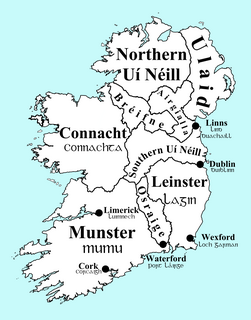
Ulaid or Ulaidh ) was a Gaelic over-kingdom in north-eastern Ireland during the Middle Ages, made up of a confederation of dynastic groups. Alternative names include Ulidia, which is the Latin form of Ulaid, as well as in Cóiced, which in Irish means "the Fifth". The king of Ulaid was called the rí Ulad or rí in Chóicid.
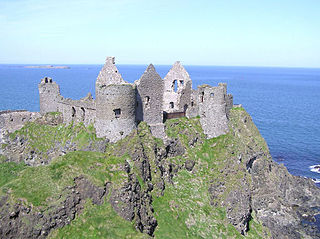
Dunluce Castle is a now-ruined medieval castle in Northern Ireland. It is located on the edge of a basalt outcropping in County Antrim, and is accessible via a bridge connecting it to the mainland. The castle is surrounded by extremely steep drops on either side, which may have been an important factor to the early Christians and Vikings who were drawn to this place where an early Irish fort once stood.
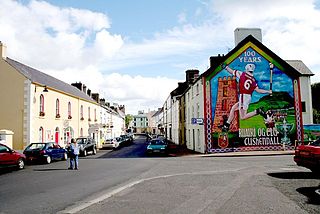
Cushendall, formerly known as Newtown Glens, is a village and townland in County Antrim, Northern Ireland. It is located in the historic barony of Glenarm Lower and the civil parish of Layd, and is part of Causeway Coast and Glens district.

Bonamargy Friary is situated in County Antrim, Northern Ireland, off the Cushendall Road on the approach to Ballycastle. The name Bonamargy means ‘foot of the Margy River’, the river formed by the joining of the Cary River and Shesk Rivers.
The Battle of Glentaisie, was an Irish battle fought in the north of Ulster on 2 May 1565. The result was a victory for Shane O'Neill over the Clan MacDonald of Dunnyveg. The conflict was a part of the political and military struggle, involving the English and occasionally the Scots, for control of northern Ireland. Although the MacDonalds were a Scottish family, based principally on the island of Islay in the Hebrides, they had long been associated with the Gaelic polity rather than the kingdom of Scotland.
Clan MacDonald of Dunnyveg, also known as Clan Donald South, Clan Iain Mor, Clan MacDonald of Islay and Kintyre, MacDonalds of the Glens (Antrim) and sometimes referred to as MacDonnells, is a Scottish clan and a branch of Clan Donald. The founder of the MacDonalds of Dunnyveg is Eòin Mòr Tànaiste Mac Dhòmhnaill, a son of Iain Mic Dhòmhnaill and Margaret Stewart.
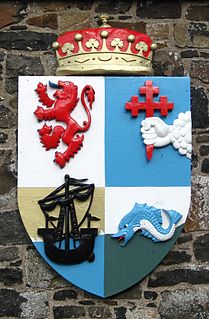
The MacDonnells of Antrim, also known as the MacDonnells of the Glens, are a branch in Ireland of the primarily Scottish-based Clan Donald. Initially part of Clan MacDonald of Dunnyveg, the MacDonnells of Antrim became their own branch in 1558 when Somhairle Buidhe MacDonnell obtained the lordship of the territory in Ireland from James MacDonald, 6th chief of the Clan MacDonald of Dunnyveg. The MacDonnells of Antrim were a sept of the powerful Clan Donald of the royal Clann Somhairle,, that the English crown had attempted to cultivate since the early 14th century in its efforts to influence the course of politics in Scotland. The MacDonnells established a growing presence in Ireland throughout the 15th and 16th centuries, and played a crucial role in the politics of 17th century Ireland. Today the surname is predominantly spelled McDonnell in Ireland and abroad. Many of the present day McDonnells have a common descent from Sorley Boy MacDonnell.

Clan MacAulay, also spelt Macaulay or Macauley is a Scottish clan. The clan was historically centred on the lands of Ardincaple, which are today consumed by the little village of Rhu and burgh of Helensburgh in Argyll and Bute. The MacAulays of Ardincaple were located mainly in the traditional county of Dunbartonshire, which straddles the "Highland Line" between the Scottish Highlands and Lowlands. Clan MacAulay has been considered a "Highland clan" by writers and has been linked by various historians to the original Earls of Lennox and in later times to Clan Gregor. The MacAulays of Ardincaple, like Clan Gregor and several other clans, have traditionally been considered one of the seven clans which make up Siol Alpin. This group of clans were said to have claimed descent from Cináed mac Ailpín, King of the Picts, from whom later kings of Scotland traced their descent. The chiefs of Clan MacAulay were styled Laird of Ardincaple.

The O'Neill dynasty is a group of families, ultimately all of Irish Gaelic origin, that have held prominent positions and titles in Ireland and elsewhere. As Chiefs of Cenél nEógain, they are historically the most prominent family of the Northern Uí Néill, along with the O'Donnell, O'Doherty and the O'Donnelly clans. The O'Neills hold that their ancestors were Kings of Ailech during the Early Middle Ages, as descendants of Niall of the Nine Hostages.
McQuillan and MacQuillan are surnames of Irish origin. There are several unrelated origins of the surnames McQuillan and MacQuillan.
The Route, also historically known as Reuta, Rowte, or in Irish: an Rúta, was a medieval territory in County Antrim, Northern Ireland, consisting of the baronies of Dunluce Upper, Dunluce Lower, Toome Lower, and the North East Liberties of Coleraine. It also formed part of the more ancient kingdoms of Dál Riata and Dál nAraidi, as well as part of the Earldom of Ulster. It was once ruled by the MacQuillans and later the MacDonnells.
Clan McQuillan is an Irish clan that descend from the north coast of Co Antrim, Ireland. Still a popular name throughout County Antrim and known for their Battles with Scottish McDonnell clan.

The history of the Bissett family in Ireland can be studied independently from that of the originally identical family in Scotland, because of their unique experience following their arrival in Ulster in the early or mid-13th century. Here, while still remaining involved in Scottish affairs, the Bissetts would establish themselves as the Lords of the Glens of Antrim and quickly become equally, then eventually more involved in the politics of the Irish province, becoming among the most Gaelicised of all the so-called Anglo-Norman families in Ireland. The heads of the leading branch of the family soon adopted the Gaelic lineage style Mac Eoin Bissett, by which they are known in the Irish annals, and which translates as "Son/Descendant of John Byset", after a prominent ancestor born in Scotland. In a number of English and Anglo-Norman sources the same head of the family is referred to as the Baron Bissett, also with variants.
John Byset the Elder, Lord of the Aird was a Scoto-Norman nobleman who is the progenitor of the Bissett family of the Glens of Antrim in Northeast Ireland or Ulster.
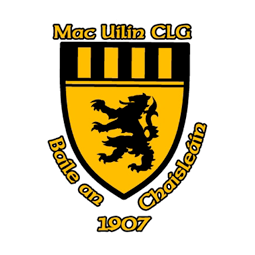
McQuillan GAC Ballycastle is a Gaelic Athletic Association club located in the town of Ballycastle in County Antrim, Northern Ireland. The club is affiliated with the Antrim county board. The club participates in both hurling and Gaelic football but is known primarily for its hurling successes. They play their home matches at Páirc MacUílín which has also hosted the Antrim Senior Hurlers in recent years due to the ongoing redevelopment of Casement Park. The Senior Hurling team is sponsored by Waste Not Ireland and the Senior Gaelic Football team is sponsored by McCurdy Surveying. Both are local businesses in the town.
The Cenél nEógain or Kinel-Owen are a branch of the Northern Uí Néill, who claim descent from Eógan mac Néill, son of Niall of the Nine Hostages. Originally their power-base was in Inishowen, with their capital at Ailech, in modern-day County Donegal in what is now the west of Ulster. Under pressure from the Cenél Conaill, they gradually spread their influence eastwards into modern counties Tyrone and Londonderry, pushing aside the Cruithin east of the River Bann, and encroaching on the Airgiallan tribes west of Lough Neagh. By the 11th century their power-base had moved from Ailech to Tullyhogue outside Cookstown, County Tyrone. By the 12th century the Cenél Conaill conquered Inishowen; however, it mattered little to the Cenél nEóghain as they had established a powerful over-kingdom in the east that had become known as Tír Eoghain, or the "Land of Owen", preserved in the modern-day name of County Tyrone.











